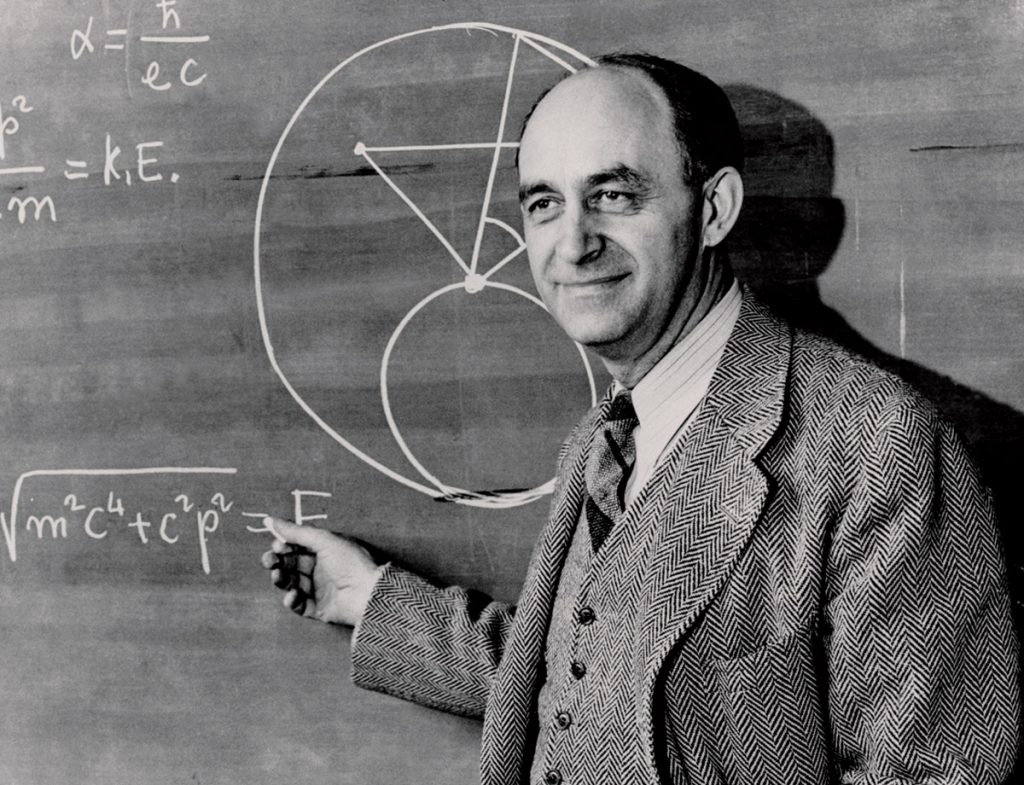Enrico Fermi (1901-1954) was an Italian physicist and recipient of the 1938 Nobel Prize in Physics.
In 1942, Fermi relocated to the Chicago Met Lab, where he built an experimental reactor pile under Stagg Field at the University of Chicago. Construction was completed on December 1 and the reactor went critical the next day. In August 1944, Fermi went to Los Alamos as an associate director and key consultant.
At the Hanford site in 1944, Fermi inserted the first uranium slug into the “B” pile reactor, just as he had for the first pile in the CP-1 reactor two years earlier. During the “B” reactor test, Fermi was in charge of directing operations. His meticulous calculations, completed on a slide rule, determined how much uranium needed to be added to the reactor; measurements confirmed that his calculations were astoundingly accurate.
The start-up failed, however, when the reactor shut itself down. John Wheeler hypothesized that some unknown substance was forming during fission and absorbing the neutrons needed to sustain the reaction. Fermi immediately agreed with Wheeler’s explanation and began working with him to find the unknown poison. By comparing the half-life of different radioactive gases with the amount of time that the reactor failed Wheeler and Fermi were able to discover that the problem substance was xenon-135.
At Los Alamos, Fermi served as an associate director of the laboratory. After the Trinity test, Fermi remarked: “My first impression of the explosion was the very intense flash of light, and a sensation of heat on the parts of the body that were exposed. Although I did not directly look towards the object, I had the full impression that suddenly the countryside became brighter than in full daylight.”
Ever the inquiring scientist, Fermi took the opportunity to conduct an experiment of his own. Just as the blast hit, he dropped several pieces of paper. Having measured their displacement and making a quick mental calculation, Fermi declared: “That corresponds to the blast produced by ten thousand tons of TNT.”
Fermi advised the Interim Committee on target selection, recommending the bombs be used without warning against an industrial target.
In 1944, Fermi became American citizen, and at the end of the war he accepted a professorship at the University of Chicago’s Institute for Nuclear Studies, a position which he held until his untimely death. There he turned his attention to high-energy physics, and led investigations into the pion-nucleon interaction. He also served on the Atomic Energy Commission’s General Advisory Committee.
The Enrico Fermi Award, a prestigious science and technology honor given by the US government, bears his name.
Scientific Contributions
In 1938, Fermi was awarded the Nobel Prize in Physics “for his demonstrations of the existence of new radioactive elements produced by neutron irradiation, and for his related discovery of nuclear reactions brought about by slow neutrons.” His research on the bombardment of elements to produce fissionable isotopes was critical to the success of the Manhattan Project.
For more information about Fermi’s scientific research and accomplishments, visit the Nobel Prize website.





